Fierce competition in the labor market, working under blackouts, massive relocations of companies and employees, and adapting work processes to unstable conditions are just some of the challenges Ukrainian companies faced during the full-scale invasion.
In this article, we will share with you the findings of our analysis on how companies performed based on Worksection analytics and external statistics from trusted sources.
Two years of war have halved the size of Ukrainian teams
Worksection's internal statistics shows a trend towards team compression. Between January 2022 and January 2024, the average team size decreased by 55%. If to drill down and differentiate by business type, we get:
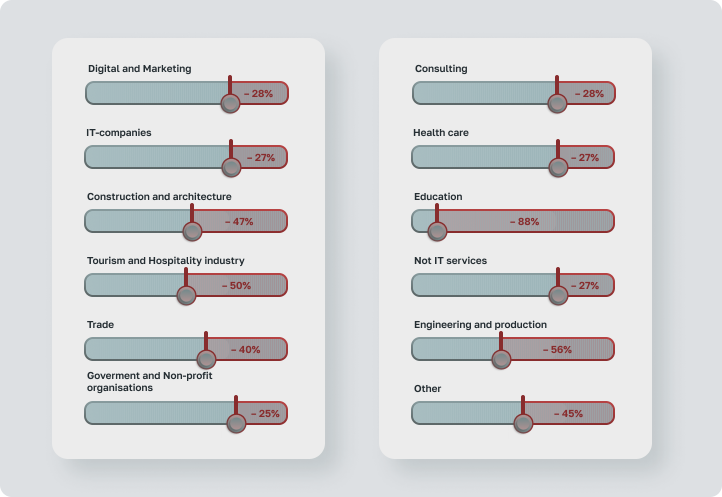
The largest decline was in Education, which fell by 88%. Next are Engineering & Manufacturing (– 56%), Tourism and Hospitality industry (– 50%), and Construction & Architecture (– 47%). The lowest percentage was shown by Government and Non-profit organizations – 25%.
It is difficult to determine the key factor that affected the results, but it was definitely influenced by: unstable external and internal market conditions; employee migration; relocation of companies; blackouts; production downtime; supply delays, etc.
That is why we were interested in analyzing the path that has brought the Ukrainian business reality to the point where we are now, and answering the question: what impact has this had on the efficiency of the Ukrainian management and teamwork?
Read the article to find out:
- First challenges: How did Ukrainian management overcome the start of a full-scale war?
- Adapting to the new reality: Management under war conditions
- Energy crisis: Working during blackouts
- Results of 2023 for Ukrainian management
- Conclusions and the role of management automation during the war.
First challenges: How did Ukrainian management overcome the start of a full-scale war?
The size of the teams had decreased by 4% by March 2022. The majority had no idea what to expect and how to deal with this uncertainty. However, far from being a cause for stoppage of work processes, it was a challenge in which Ukrainian business demonstrated its social responsibility and civic position.This is how Anastasia Nikitina, executive director of “Nash Format” publishing company, describes the full-scale war period:
Since 2022, our company has faced significant challenges and shown remarkable resilience. In spite of the difficult conditions, we have managed to keep our team together and to continue our work, even during the war. Supporting the military and medical professions and developing the Ukrainian book market have been the focus of our efforts.
By business type, the reduction in teams as of March 2022 is as follows:
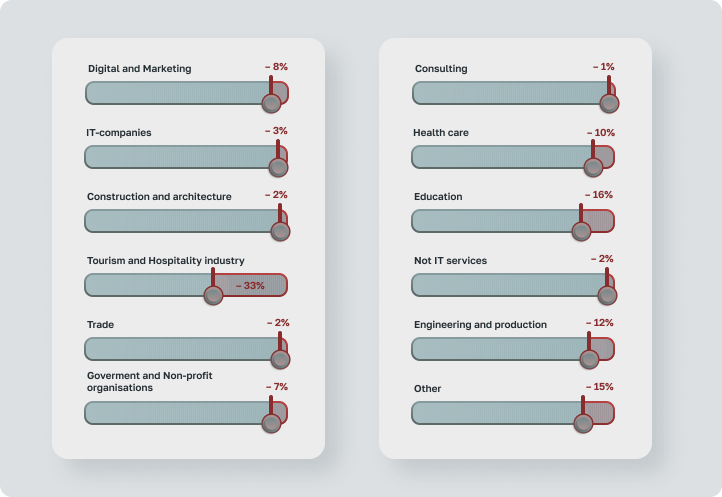
Tourism and Hospitality industry sector had the largest losses (–36%), followed by Education (–16%), Engineering & Manufacturing (–12%) and Healthcare (–10%).
Of course, russia's invasion of Ukraine had an impact on performance as well, despite the business's commitment to face the challenges.
Team performance during the first month of the full-scale war
In March 2022, the number of completed projects decreased by 45% and the number of closed tasks decreased by almost 50%, which clearly shows the impact of 24 February 2022 on Ukrainian business.
Let’s have a look ar the percentage of completed projects divided by types of enterprise:
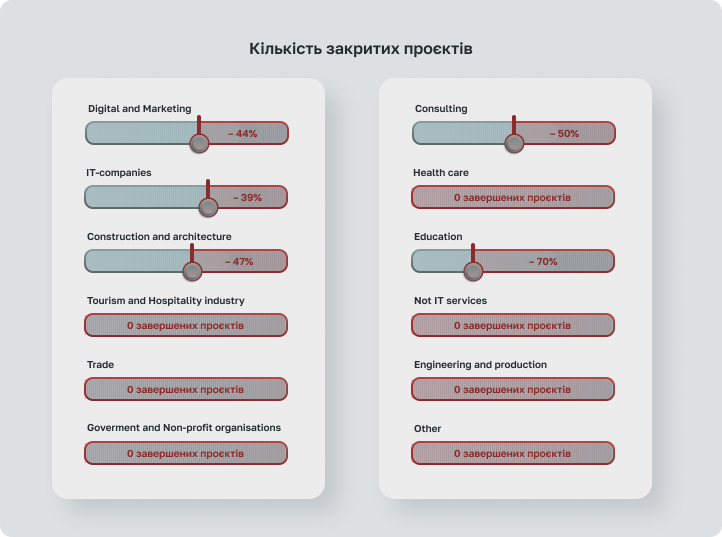
IT professionals remain the most active over this period. They had the lowest percentage decline of completed projects which is –39%. Nevertheless, more than half of the industries in the sample had zero completed projects in March 2022, including: Tourism & HoReCa; Commerce, Government & Non-profit organizations; Health; Non-IT Services; Engineering and Manufacturing; and Other.
In terms of the number of completed tasks by businesses segment, we can see following results:
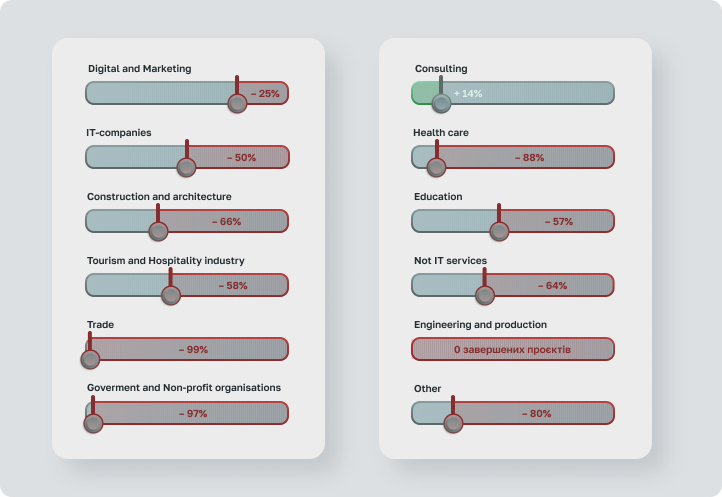
Consulting became the leading segment with a 14% increase in tasks fulfillment. The sectors that have suffered the most since the beginning of the war are Engineering and Manufacturing (0 completed tasks), Trade (– 99%), Government & Non-profit organizations (– 97%) and Health (– 88%).
Our analysis provides information about the impact of russian aggression on the performance of Ukrainian businesses since the start of the full-scale invasion. As we can see from the data, commerce and production companies, as well as government and non-profit organizations, have suffered the most.
Adapting to the new reality: Management under war conditions
Labour market conditions in April-September 2022
According to the International Labour Organization, nearly five million jobs have been lost in Ukraine because of the war. The internal Worksection analytics shows that in the six months of full scale war, the labour force decreased in general by 8%. The war has significantly reduced the Ukrainian labour market due to the migration of citizens, their forced residence at the areas of temporary occupation, joining the armed forces of Ukraine, etc.
The reduction in the number of employees by type of enterprise is:
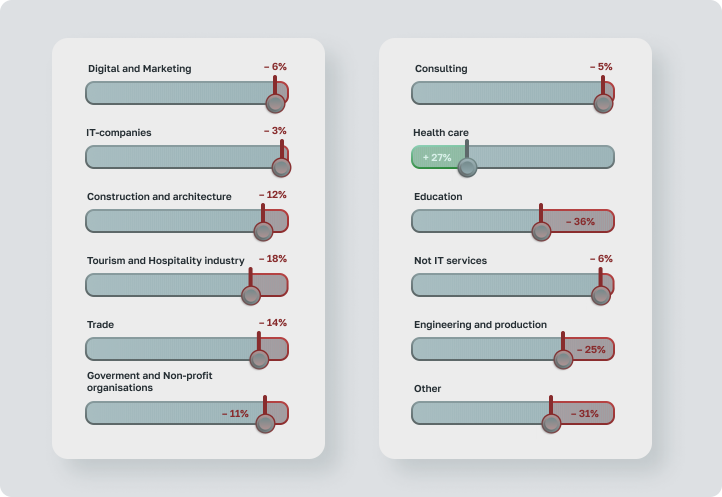
As we can see, only the Health segment showed positive dynamics, with an increase in the average staff size by 27%. All other types of business tended to reduce their teams over a given period of time.
However, the negative dynamics is not common to all businesses. For example, the Logics7 team managed to grow from 15 to 80 employees during the full-scale war.
Logics7's Administrative Director Natalia Kunitsa comments:
Our activities facilitated the growth of the team. We produce battle simulators, which is highly relevant for Ukraine. We started this back in 2019, but at the beginning of the full-scale invasion we reorganized into a new team.
Obviously, there are exceptions to every statistic. But we wonder how the realities of the Ukrainian labour market have affected the efficiency and performance of teams?
Analysis of teamwork effectiveness for April-September 2022
To analyze our performance, we decided to look at the number of closed tasks in Worksection from April to September 2022:
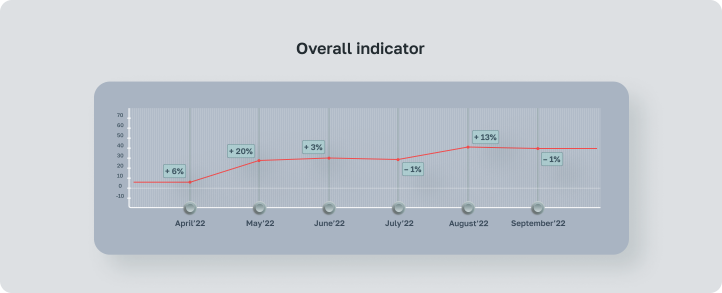
The diagram shows the dynamics of closing tasks compared to the previous month. In the context of these six months, the average increase in efficiency was 7%.
After analysing the same data, segmenting it by business type, we obtained the following results:
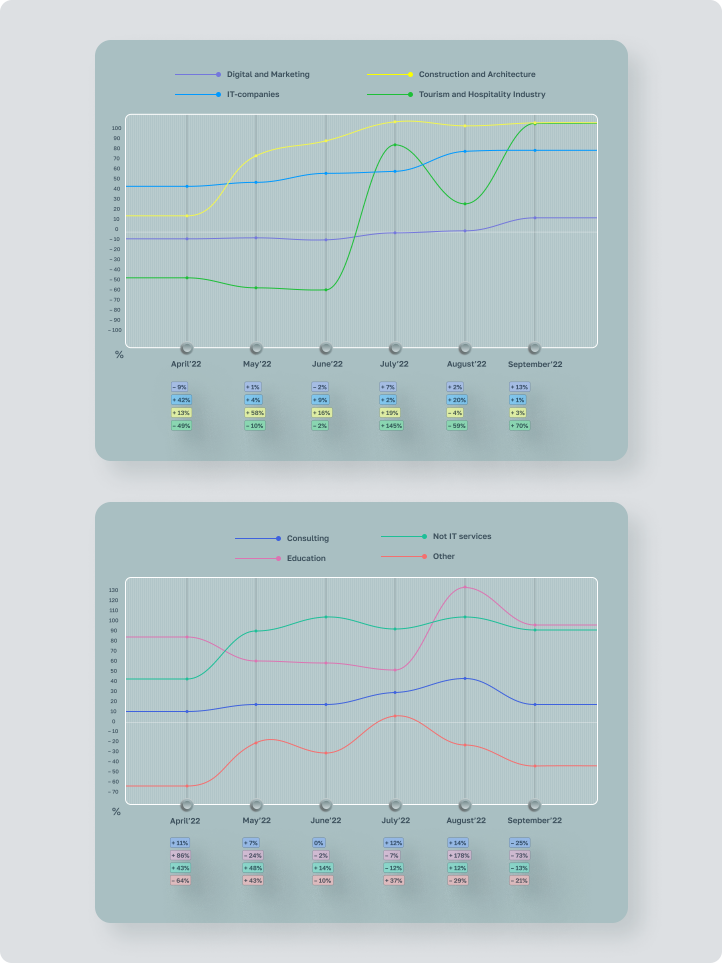
We would also like to highlight the types of businesses that have multiplied their efficiency potential several times since the beginning of the war:
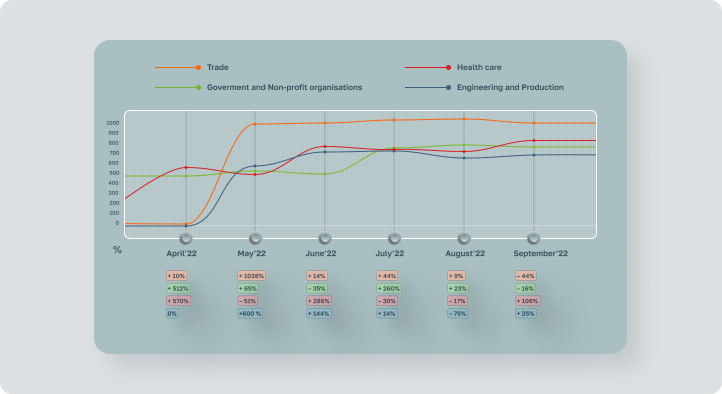
So, despite the difficult labour market conditions and the reduction of teams, Ukrainian business had a relatively positive performance dynamics.
For example, this is how Oleksandr Ostapenko, co-founder of Kompozit, comments on the work during the full-scale war:
For the period from early 2022 to early 2024, our business showed, in my opinion, good results, taking into account the war in our country. Of course, there was no growth, but in general, we are satisfied with the results. We have kept all the important staff and preserved almost all products. Some product lines even showed strong growth.
Energy crisis: Working during blackouts
Teamwork also continued during the blackouts. Let's take a closer look at what the period of October 2022 – March 2023 was like for Ukrainian business.
How did the blackouts affect the teams?
In the autumn of 2022, Ukraine faced massive power cuts. This affected every aspect of Ukrainian life, and business was no exception. During the six months of blackouts, the size of teams is estimated to have decreased by 6%.
The dynamics by type of business are:
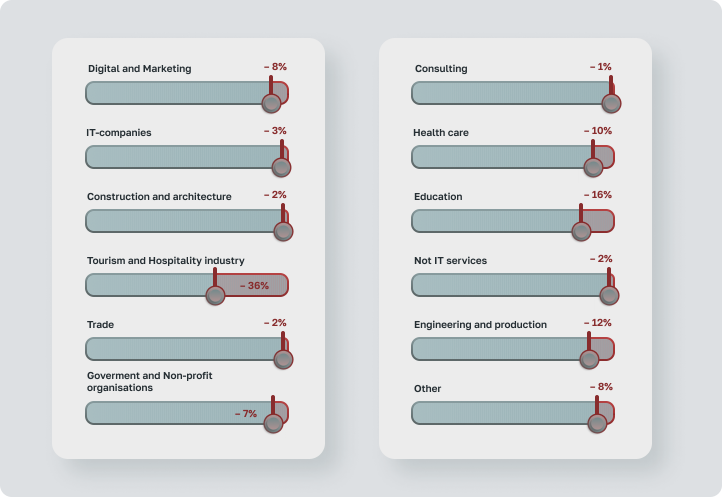
During the blackout time, the Tourism and Hospitality industry sector experienced the largest decline among the teams, with a 36% drop.
At the same time, the total number of projects remained roughly the same, with a positive trend in their closure. Between October 2022 and March 2023, the number of completed projects increased by 30%.
Our stable position helps us to stay on track. We have never published or sold a russian book. We supported and developed the Ukrainian book market. That's why we didn't have to fully transform or reorganize our activities.
Anastasia Nikitina, Executive Director of “Nash Format” Publishing Company
Business performance in blackouts
We used our internal Worksection analytics to analyze the dynamics of Ukrainian business performance. To do this, we took the number of closed tasks for the period from October 2022 to March 2023 and compared them all to the number of closed tasks in September 2022.
This selection was made to compare the impact of blackouts on team performance and to illustrate how quickly the business managed to recover and reach pre-blackout performance.
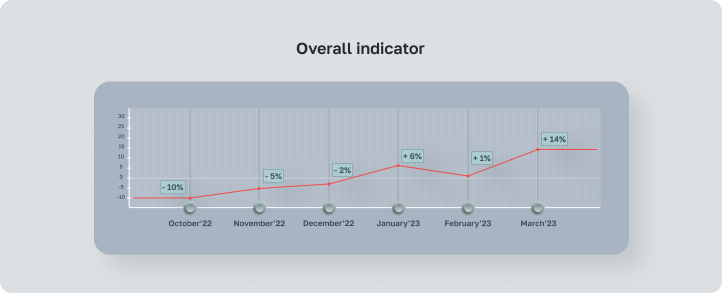
Therefore, working efficiency dropped by a tenth in October. As we know, on 10 October the russians launched massive attacks on Ukraine's energy infrastructure, which affected the productivity of Ukrainian companies.
We also show you the percentage change in the indicators with monthly dynamics to illustrate the overall performance. This shows how each new month performed compared to the previous one:
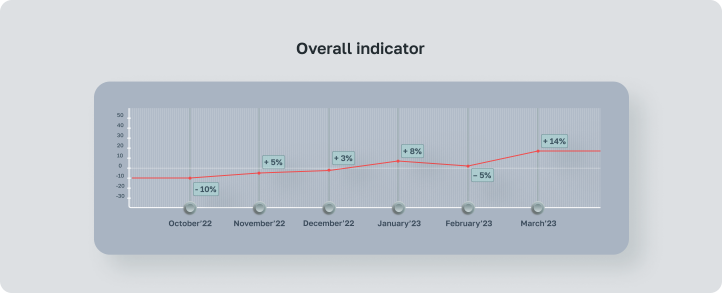
Despite such a significant hit in October 2022, the following months show a positive dynamic towards the recovery of production volumes, with a projected decline in February 2023 due to increased attacks by russia.
It is also interesting to analyze the performance of each business segment separately in terms of monthly dynamics from October 2022 to March 2023:
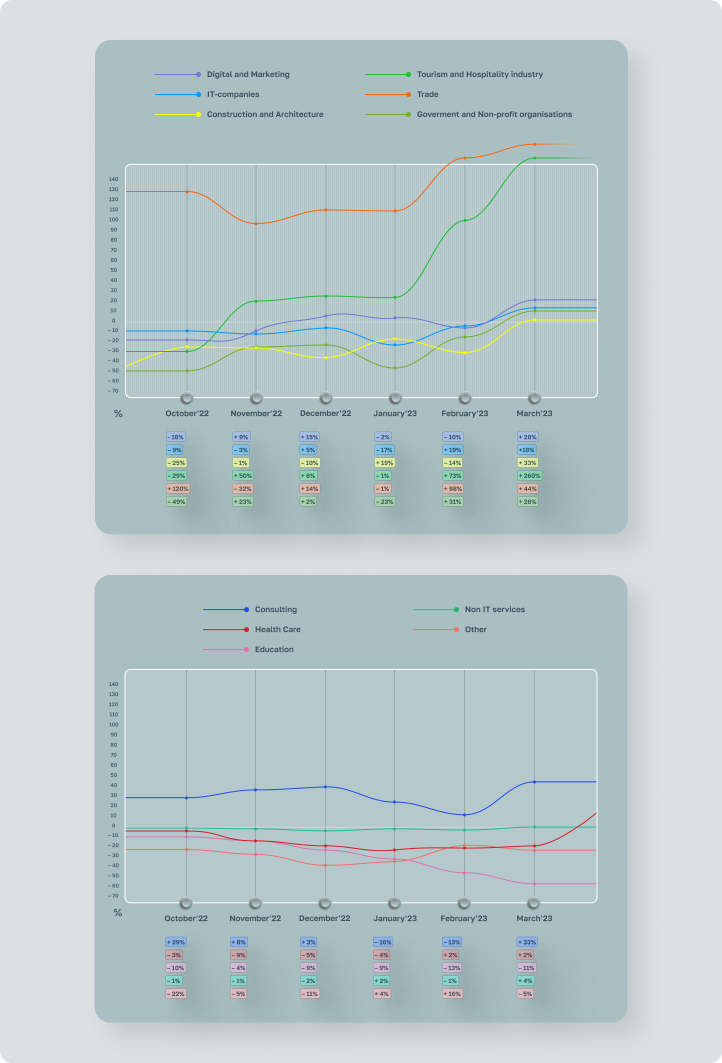
From the total amount of data obtained, we would like to single out the Engineering and Production sector with a rapid increase in efficiency in December 2022:
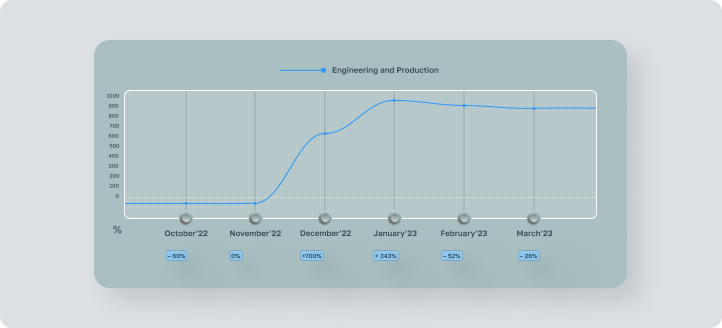
Our analysis shows that Ukrainian companies were able to adapt their operations during the massive blackouts. As expected, the biggest hit to efficiency came at the beginning of the blackout period, in October-November 2022. However, by March 2023, the majority of companies managed not only to stabilize their performance, but also to increase it.
Results of 2023 for Ukrainian management
Staff reduced by 35% in 2023
Based on our research, we have determined that Ukrainian teams have decreased by a third, or more precisely by 35%, from January to December 2023.
The breakdown by business type is:
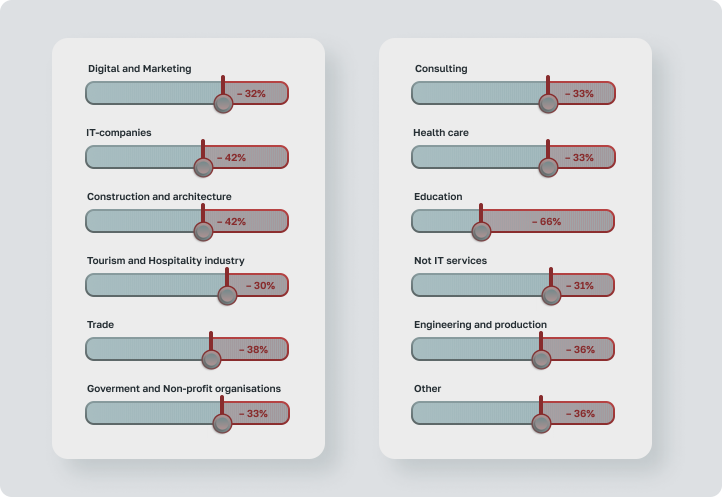
The Education sector experienced the biggest losses, down 66%. The marketing segment reduced its staff by almost a third (– 32%). IT companies, together with the Construction and Architecture sector, decreased by 42%.
The total number of job offers for specialists also decreased from 705.8 thousand in 2021 to 329.4 in 2023, according to the State Employment Service of Ukraine, which is a percentage decrease of 53%.
Team performance in 2023
Based on internal analytics, we are also able to analyze the performance of Ukrainian businesses in 2023. For example, 92% of the total amount of tasks set in 2023 was completed. We also have the results of the analysis with the percentage of tasks completed by business type:
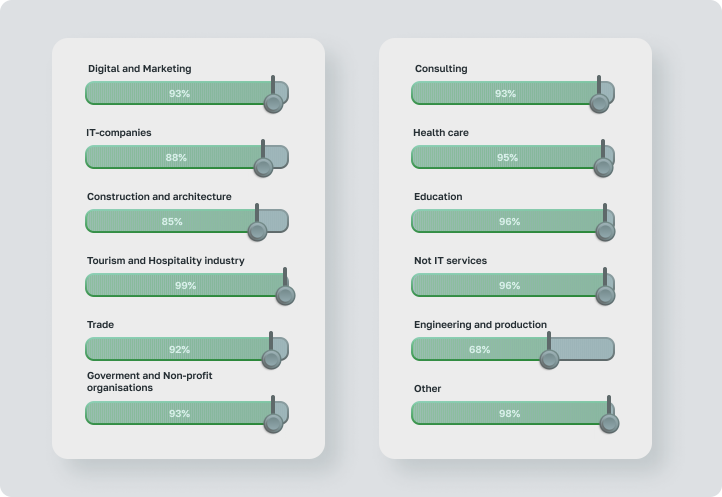
The analysis shows that the lowest percentages of tasks were completed in Engineering & Manufacturing (68%) with Construction & Architecture (85%). Other areas maintained productivity levels of 90% or higher throughout the year.
Oleksandr Ostapenko, co-founder of Kompozit, comments on how they managed to maintain business results during the war:
A number of factors contributed to this, but the main ones were: Expanding the range of products and maintaining quality in the existing ones; Improving the quality of customer service; Effective use of marketing strategies and advertising campaigns (internet sales); Entering new markets outside Ukraine; Continuous improvement of business processes and optimization of the company's internal operations.
Conclusions for 2023
Although there was a tendency for the Ukrainian teams to become tighter, this did not affect the business's performance in general. If we look at the dynamics of the volume of closed tasks in 2023, we get the following results:
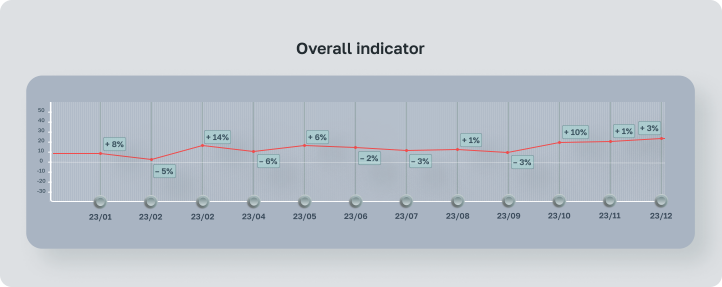
By type of business, the same dynamics look like:
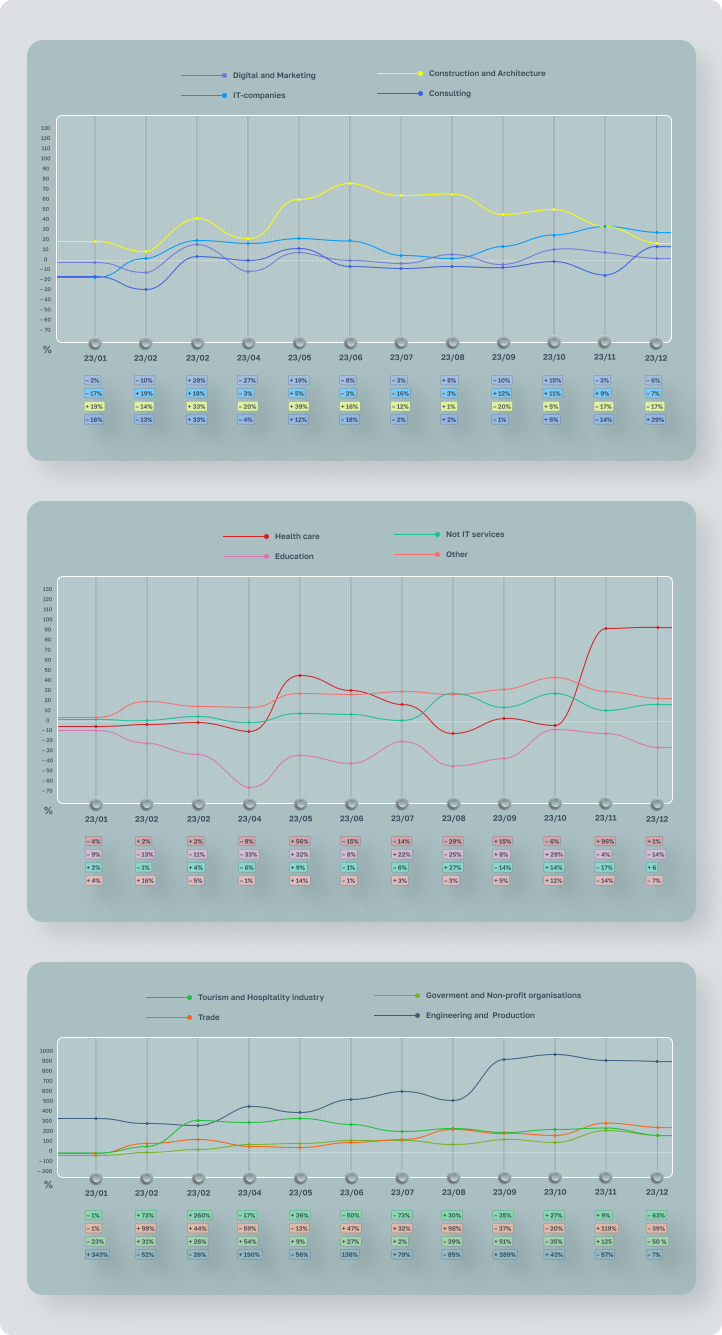
Summary
To summarize, the size of Ukrainian teams during the full-scale war tended to decline, which can be seen in each of our tables. The performance indicators had less predictable dynamics and their values fluctuate depending on the given period and the chosen type of business.
The role of management automation during the war
We believe that the use of tools for automating work processes greatly simplifies workflow coordination and helps to assess efficiency. Worksection is a Ukrainian product that has been in operation since the beginning of the war under the pressure of russian aggression and other external factors. This is how our clients comment on working with Worksection:
Worksection's well-tailored features and capabilities allowed us to effectively manage projects and tasks, automate employee interaction processes, and analyze data to make strategic decisions.
Natalia Kunitsa, Administrative Director at Logics7:
We use Worksection for communication, task setting, and automation. In the future, we plan to use the system to optimize processes using metrics from Worksection.
Anastasia Nikitina, Executive Director of “Nash Format” Publishing Company:
We need Worksection to systemize our work and grow.
Instead of conclusions
Therefore, we have observed the history of Ukrainian management during the period of the full-scale invasion in terms of the size of teams and their effectiveness. This research was made possible because our users chose Worksection.
The deep analytical base allows you to analyze not only the efficiency of your business, but also the performance of an entire field. In the future, we will continue to research the Ukrainian business segment and share the results in our next internal studies.
So, stay tuned 
